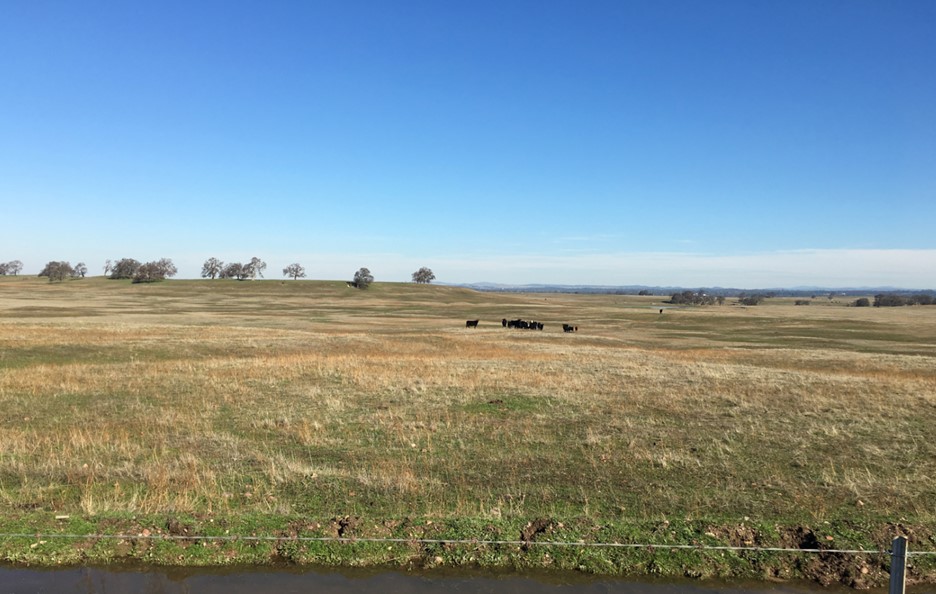project focused on sustainable land use planning.
Find out more about us >>
Open Space and Carbon: Calaveras County Greenhouse Gas Baseline Reduction Plan
CAP Governing Committee Member Muriel Zeller provided the following letter explaining the role rangelands play in carbon sequestration. A Greenhouse Gas Baseline and Reduction Plan for Calaveras County is under development, and the conservation of rangelands should be a positive part of that plan.
Hello, Mr. Frisch.
I understand the Sierra Business Council is working on the Greenhouse Gas Baseline and Reduction Plan for Calaveras County. As a resident of Calaveras County, I urge you to take into consideration the role that rangeland plays in carbon sequestration both in establishing the baseline and in any plan for the reduction of carbon emissions. “A study from the University of California, Davis, found that grasslands and rangelands are more resilient carbon sinks than forests in 21st century California… Unlike forests, grasslands sequester most of their carbon underground, while forests store it mostly in woody biomass and leaves. When wildfires cause trees to go up in flames, the burned carbon they formerly stored is released back to the atmosphere. When fire burns grasslands, however, the carbon fixed underground tends to stay in the roots and soil, making them more adaptive to climate change… The study does not suggest that grasslands should replace forests on the landscape or diminish the many other benefits of trees. Rather, it indicates that, from a cap-and-trade, carbon-offset perspective, conserving grasslands and promoting rangeland practices that promote reliable rates of carbon sequestration could help more readily meet the state’s emission-reduction goals (excerpted from: “In Wildfire-Prone California, Grasslands a Less Vulnerable Carbon Offset Than Forests” by Kat Kerlin, July 9, 2018, UC Davis Science and Climate: https://climatechange.ucdavis.edu/news/grasslands-more-reliable-carbon-sink-than-trees/).” I have attached the actual study for your convenience.
As you know, about 30% or 198,000 acres of Calaveras County is privately owned rangeland. The California General Plan Guidelines state, “Together with the conservation element, an open space element identifies areas that provide value in an essentially undeveloped condition and creates a plan to preserve such areas (Chapter 4, Required Elements, page 121).” The Calaveras County General Plan adopted in November 2019 does not adequately identify valuable open space such as rangeland nor does it create a preservation plan for open space. According to Government Code Section 65560, “(a) ‘Local open-space plan’ is the open-space element of a county or city general plan adopted by the board or council, either as the local open-space plan or as the interim local open-space plan adopted pursuant to Section 65563.” The policies of the open space element must provide that open space “be conserved wherever possible.” In addition, the open space element must include an inventory of open space land. The General Plan does not even include an open space map. There is an open space map dated 2015 in the Background Report, but the Background Report is not part of the General Plan, and the 2015 map does not properly identify all open space. In particular, it does not identify all conservation easements, the epitome of open space.
The most recent California Conservation Easement Database map shows 19,349.4 acres in Calaveras County as permanently protected, but the actual amount is well over 20,000 acres. This protected open space must not be ignored in the Greenhouse Baseline and Reduction Plan, and the placement of conservation easements on rangeland cannot be ignored as a strategy for the reduction of greenhouse gases. Rangeland “should be protected from conversion pressures and degradation that could result in significant carbon emissions. In addition, restoration and improved management practices to increase carbon storage should be incentivized. This is true particularly where such enhancement, protection, and conservation action provide other important climate benefits, such as improving watershed conditions and food protection, and providing habitat and connectivity for climate stressed species (California’s Climate Change Scoping Plan, page 74).” My fear is that Calaveras County’s disregard for the value and importance of rangeland and other open space will negatively impact its Greenhouse Gas Baseline and Reduction Plan, even though there are other multiple ecosystem and economic benefits associated with rangeland protection and preservation. Thank you for your time and consideration.
Regards,
Muriel Zeller
cc: Community Action Project Governing Committee
Tom Infusino, Calaveras Planning Coalition Facilitator
Chris Wright, Mother Lode Land Trust Board President


